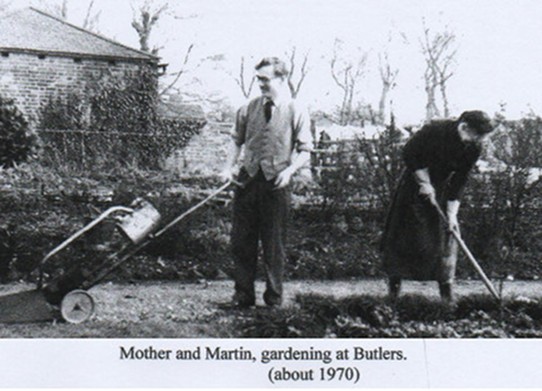LIFE AT BUTLERS - 11
Postscript
By Martin Edgar
11. POSTSCRIPT
This is a story of a childhood and growing up. But it is also two other stories as well.
First, it is a story of a place. Butlers has been there for a long time. I don't have accurate details, but I seem to remember that it is named after one William le Bottelier, who lived there probably in the 1300s. As Sutton Church is late 1100s or early 1200s, there must have been Norman settlements around here from those times, to justify the expense of putting up a good flint church. Then you have the moat, probably mediaeval and like other examples in East Anglia, which was more to provide fish and eels than for security. After all, it goes round only two sides of the house. The house itself was built in the early 1700s - again a fairly classic East Anglian design; timber-framed and with weatherboard cladding, which had to be painted every four years. As I remember it, the Tabors (as landlords) paid for the labour, and we paid for the materials. Being a timber structure, it tended to move and flex a bit, depending on the weather, with perpetual drafts as a result. So it was a chilly house, but if you were brought up in it you were used to that. The barn was probably mediaeval, and goodness knows when the rest of the farm buildings went up - probably in the late 19th or early 20th century. So, this story of the place moves on to recent history and how it was only 60 years ago.
Second, it is also a story of a small and fairly self reliant country community, where the last of the old Victorian values were still hanging on. We were a mile and a half from the nearest bus and the nearest town (Rochford) was two miles away, and so the farm had to have cottages for its workers to be close to where they worked. Father was the only one with a car, so everybody else walked or went by bicycle. The men had their own plots of land by their cottages to grow their own vegetables, and I dare say the odd rabbit and hare were taken. This relative remoteness meant that there was an underlying reliance on each other, and there was a feeling of permanence in this arrangement; each of the men with cottages knew that they had them for as long as they were working, and for their retirement after that. But you cannot ignore that it was still a structured society, where people were aware of their place and, while generally comfortable with it, could not easily get out and improve themselves. The established social structure meant that we were friendly with Dennis Brown, the local JP and Deputy Lieutenant for the county, who lived a mile or so away, but we did not go to tea there. We were tenant farmers, albeit fairly substantial ones, and Father was Church Warden at Sutton Church, as was Mother after him. However, the men went to their chapel at the end of the drive. But we all met together at the church for the annual Harvest Festival. At home, Adri (the au pair) ate with the family, but Beryl (who came in to help with the cooking and the house work) did not. She had her meals in the kitchen. And so on.

All that is now gone. The farm has been taken in hand by the Tabor Estates, and is part of a farming unit of 2000 acres or more. Nobody who works at Butlers lives there. The house now has a Tabor family living happily in it. Some of the cottages are let out, and Cadges cottage is home to an art club. The chitting shed houses a vintage car repair business, the yards are used as livery stables to house horses owned by people in the nearby towns. The men's chapel houses a small business. There is unused space elsewhere as there are no longer any cows or farm horses. Even the old stables have been pulled down. So it is part of a different regime, and there is plenty of life there, but it is a very different life.
Martin Edgar, August 2013.